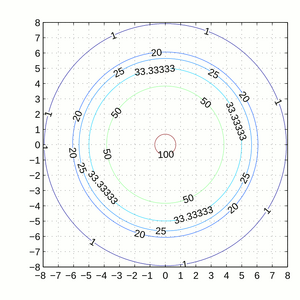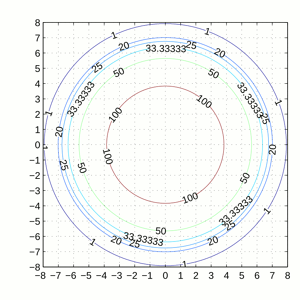Plantilla:Corregir
Dinamita explotando.
Una explosión es un suceso físico y, por lo general, destructivo, que puede ocurrir por varias circunstancias. Puede destruir bloques cercanos, causar daños a los jugadores cercanos, entidades y armaduras y, a veces, producir fuego. Las explosiones reproducen el efecto de partículas "shockwave" (onda expansiva).
Múltiples explosiones cercanas pueden lanzar objetos más lejos, pero no tiene efecto acumulativo en la destrucción de un bloque. Esto se debe a que el daño de las explosiones producido en los bloques es evaluado individualmente (por explosión), y la resistencia a las explosiones de cada bloque no se ve debilitado acumulativamente por cada explosión.
Los bloques "destruidos" tienen la posibilidad de dropearse para ser recolectado (o de lo contrario, desaparece), y está probabilidad es uno dividido por el poder de la explosión. Así, la explosión de un creeper (no cargado) tendrá 1/3 de dropear un bloque.
El efecto de propulsión de las explosiones es a menudo usado para cañones de TNT.
| Tipo de explosión | Potencia | Notas |
|---|---|---|
| Plantilla:EntityLink (al aparecer) | 7 | |
| Plantilla:EntityLink | 6 | Puede hacer fuego |
| Plantilla:EntityLink | 6 | |
| Cama (en el Nether o el End) | 5 | Hace fuego |
| Dinamita | 4 | |
| Plantilla:EntityLink | 3 | |
| Plantilla:EntityLink (bola de fuego) | 1 | Hace fuego |
| Plantilla:EntityLink | 1 | |
| Plantilla:EntityLink | 1 | Lanza bloques explosivos que destruyen todo menos lo que tenga una resistencia contra explosiones de más de 4 (tampoco destruye la Piedra madre ni el Marco del portal del End). |
Efecto
Modelo de destrucción del bloque
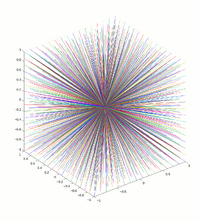
1352 rayos desde el centro de la explosión de puntos que se distribuye uniformemente sobre la superficie de un cubo centrado en la explosión con una longitud de arista de 2. (Sin embargo, esto sólo define sus direcciones, no su longitud)
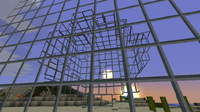
El patrón, más o menos esférico, de bloques destruidos se puede ver así.
Una explosión puede destruir bloques cercanos. Su efecto explosión se evalúa de forma independiente en muchos rayos de explosión originarios del centro de la explosión, como se muestra en la figura de la derecha.
- Cada rayo tiene una fuerza explosión inicial aleatoria de [0,7 × potencia, 1,3 × potencia].
- El efecto de la fuerza de la explosión se examina en los controles sobre el rayo con la longitud de 0,3.
- La fuerza de la explosión es absorbida (Resistencia a explosiones / 5 + 0.3) x longitud por el bloque no aéreo (no importa si se destruye) en cada punto de control y atenuada por la longitud × 0,75 entre los puestos de control, hasta su total absorción o atenuación.
- Un bloque se considera destruido si no puede absorber por completo la fuerza de explosión en cualquier punto de control (los bloques de aire también pueden ser destruidos).
From the above process, the following results can be deduced (where ⌊x⌋ is the floor function):
- The blast radius in the air of an explosion (i.e. only attenuated, not absorbed by blocks) = ⌊1.3 × power/(step length × 0.75)⌋ × step length = 10.2 (charged creepers), 6.9 (TNT), 5.1 (creepers), 1.5 (fireballs). For example, a TNT explosion can destroy a torch 7 blocks away. But how many blocks an explosion can destroy is non-deterministic and also dependent on the specific location of the explosion.
- The minimum block resistance required to absorb maximum blast force of an explosion happening in nearby air = ((1.3 × power − attenuation steps × step length × 0.75)/step length − 0.3) × 5. To not be destroyed, a block has to absorb all blast force at the first checkpoint in it.
- The attenuation steps is subject to collision restrictions. For explosion in air, there is at least one attenuation step. TNT and creeper explosion are always 0.49 and 0.5 meter away from nearest block (2 att. steps), but fireball explosion can happen anywhere (1 att. step).
- Thus, the block resistances are 121.00 (charged creepers), 77.67 (TNT), 56.00 (creepers), 16.42 (fireballs).
- So water, lava (Note: Only the stationary block) obsidian, and bedrock are always indestructible, and fences and less blast-resistant blocks can be destroyed by fireballs. These are theoretical values, and in reality less resistant blocks are not always destroyed, and since Minecraft is supposed to be simple, there is no such mechanic.
Interaction with entities
An explosion has different effects on entities than blocks. Entities are damaged and propelled by an explosion if within its damage radius of 2 × power. Note that the "damage radius" is different from the blast radius of explosion effect on blocks.
- For each entity within the radius, define impact = (1 − distance from the explosion/radius) × exposure.
- Apply (impact2 + impact) × 8 × power + 1 point (half-heart, so we don't have to divide by 2 everywhere) of damage to the entity.
- Propel the entity so that its velocity increases by impact in the direction from explosion to the entity.
From the above process, the following results can be deduced:
- Entities will always get at least 1 point of damage if they are within the radius, regardless of their explosion exposure.
- The maximum damage that entities can take (at the explosion center with 100% exposure) = (1 × 1 + 1) × 8 × power + 1 point of damage = 97 (charged creeper), 65 (TNT), 49 (creepers), 17 (fireballs). When entities are away or covered by blocks from the explosion center, they take less damage.
- The maximum velocity gain that an entity can obtain from a TNT explosion is 1, at the explosion center with 100% exposure.
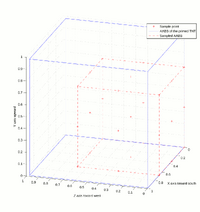
A primed TNT AABB has directionally asymmetrical sample points (1/2.96 spacing) because of rounding.
Calculation of explosion exposure
Explosion exposure is simply how much an entity is visible from the explosion center, and is approximated with the ratio of visible sample points on the entity. The approximation algorithm has sampling error that results in directional asymmetry of propulsion. For example, a typical TNT Cannon has maximum range in the west direction partly because the primed TNT has largest sampled exposure in that direction.
Causing fire
If the explosion has the ability, it randomly starts fires in ⅓ of all destroyed air blocks that are above opaque blocks.
Permanent lag
Permanent lag is essentially lag-fallout from an explosion, this consists of drops, liquid-physics, and increased render-complexity of the crater. Technically the drops will disappear after 5 minutes, however that's 5 in-game minutes which may take a long time to process during extreme lag.
It is recommended that when making a large creative-mode explosion, one uses the command "/gamerule doTileDrops false" to stop drops from being generated by explosions. If you are using 1.8 or higher the code "/kill @e[type=Item]" will destroy all drops, however in 1.7 or earlier the same code will just kill the player.
Resistencia a explosiones
| Nombre del bloque | Resistencia a explosión |
|---|---|
| Barrera |
18.000.004 |
| Piedra base |
18.000.000 |
| Bloque de comandos |
18.000.000 |
| Portal del Fin |
18.000.000 |
| Marco de portal del Fin |
18.000.000 |
| Yunque |
6.000 |
| Mesa de encantamientos |
6.000 |
| Obsidiana |
6.000 |
| Cofre del fin |
3.000 |
| Agua fluyendo |
500 |
| Lava |
500 |
| Agua |
500 |
| Huevo de dragón |
45 |
| Piedra del Fin |
45 |
| Bloque de diamante |
30 |
| Bloque de esmeralda |
30 |
| Bloque de oro |
30 |
| Bloque de hierro |
30 |
| Bloque de redstone |
30 |
| Ladrillos |
30 |
| Escaleras de ladrillos |
30 |
| Arcilla endurecida |
30 |
| Roca |
30 |
| Escaleras de roca |
30 |
| Muro de roca |
30 |
| Barrotes |
30 |
| Tocadiscos |
30 |
| Moss Stone | |
| Nether Brick | |
| Valla de infradrillo |
30 |
| Escaleras de infradrillo |
30 |
| Piedra |
30 |
| Ladrillos de piedra |
30 |
| Escaleras de ladrillos de piedra |
30 |
| Losas de piedra | |
| Puerta de hierro |
25 |
| Generador de criaturas | |
| Telaraña |
20 |
| Dispensador |
17,5 |
| Soltador |
17,5 |
| Horno |
17,5 |
| Faro mágico | |
| Mena de carbón |
15 |
| Cacao | |
| Mena de diamante |
15 |
| Mena de esmeralda |
15 |
| Valla | |
| Puerta de valla | |
| Mena de oro |
15 |
| Tolva |
| Nombre del bloque | Resistencia a explosión |
|---|---|
| Mena de hierro |
15 |
| Bloque de lapislázuli | |
| Mena de lapislázuli |
15 |
| Mena de cuarzo |
15 |
| Mena de redstone | |
| Trampilla |
15 |
| Madera | |
| Puerta de madera | |
| Wood Slabs |
15 |
| Wood Stairs |
15 |
| Cofre |
12,5 |
| Mesa de trabajo | |
| Trapped Chest |
12,5 |
| Caldero | |
| Madera | |
| Librería |
7,5 |
| Calabaza iluminada | |
| Sandía |
5 |
| Mob head |
5 |
| Calabaza |
5 |
| Cartel |
5 |
| Bloque de cuarzo |
4 |
| Escaleras de cuarzo | |
| Bloque musical | |
| Arena | |
| Escaleras de arena | |
| Lana |
4 |
| Monster Egg |
3,75 |
| Raíl activador | |
| Raíl detector | |
| Powered Rail |
3,5 |
| Raíl | |
| Bloque de arcilla | |
| Tierra de cultivo | |
| Césped | |
| Grava | |
| Esponja |
3 |
| Soporte para brebajes | |
| Botón | |
| Tarta | |
| Tierra | |
| Bala de heno | |
| Hielo | |
| Palanca | |
| Micelio | |
| Pistón | |
| Pistón extendido | |
| Placa de presión | |
| Arena |
| Nombre del bloque | Resistencia a explosión |
|---|---|
| Arena de almas | |
| Pistón pegajoso | |
| Placa de presión por peso | |
| Cactus |
2 |
| Escalera |
2 |
| Infiedra |
1,5 |
| Cristal | |
| Panel de cristal | |
| Glowstone |
1,5 |
| Redstone Lamp |
1,5 |
| Stained Glass |
1,5 |
| Stained Glass Pane |
1,5 |
| Cama |
1 |
| Sensor de luz solar | |
| Huge Mushrooms |
1 |
| Hojas | |
| Nieve | |
| Enredadera | |
| Alfombra | |
| Capa de nieve | |
| Aire | |
| Zanahoria | |
| Arbusto muerto | |
| Fuego | |
| Maceta | |
| Flores | |
| Flowing Lava |
0 |
| Hierba | |
| Nenúfar | |
| Locked Chest |
0 |
| Melon Stem |
0 |
| Champiñones | |
| Nether Portal |
0 |
| Verruga infernal | |
| Piston Moving |
0 |
| Patata | |
| Pumpkin Stem |
0 |
| Comparador de redstone | |
| Repetidor de redstone | |
| Antorcha de redstone | |
| Redstone Wire |
0 |
| Brote | |
| Trigo | |
| Caña de azúcar | |
| TNT |
0 |
| Antorcha |
0 |
| Tripwire |
0 |
| Tripwire Hook |
0 |
Typical damage radius
The player will receive damage, if within these radii of a 100% exposure ground 1-, 2-, or 4-TNT explosion, with the amount of damage labeled on each circle in the figures below.
Historial
| st | |||||
|---|---|---|---|---|---|
| 0.24 | Creepers were first introduced in on August 24, 2009, based on a failed pig model Notch had created. | ||||
| 0.26 (24 de octubre de 2009) | Se añadió la dinamita. | ||||
| a | |||||
| 1.2 | Se han añadido los ghasts, que lanzan bolas de fuego explosivas. | ||||
| b | |||||
| 1.5 | Creepers become charged when struck by lightning, increasing the explosion's radius and strength. | ||||
| 1.6 | Trying to sleep in the Nether causes the bed to explode. | ||||
| 1.8 | Explosions will now emit shockwave particles after exploding. Prior to Beta 1.8, explosions only emitted smoke. | ||||
| 1.9pre3 | Bed and ghast explosions cause fire. | ||||
| 1.9pre4 | Trying to sleep in the End causes the bed to explode. | ||||
| Enchantment "Blast Protection" added, protecting against explosions. | |||||
| 1.9pre6 | Ender Crystal added, an entity which sits atop of a block of bedrock. It can be destroyed with a melee or hit with an arrow or snowball, causing an explosion. | ||||
| Sound Update | The 'Sound Update' of November 13th 2011 gave TNT a new explosion sound. | ||||
| r | |||||
| 1.3.1 | 12w24a | Fixed explosions not pushing back players. | |||
| 1.3.1 | Explosions damage the player different amounts on different difficulties, and no damage is dealt to the player on peaceful. | ||||
| 1.4.2 | 12w34a | Added the Wither, which shoots black wither skulls. | |||
| 12w37a | Wither will make a massive explosion upon its creation after its health is fully charged. | ||||
| Blue wither skulls added. | |||||
| 12w38b | New Creeper fall mechanics; Creepers will explode if they fall on the player from a certain height. | ||||
| 1.5 | Destroyed blocks have a 1/power chance of dropping as items; previously it was a fixed 30% chance. | ||||
Curiosidad
- Explosions more powerful than 100 look mostly the same from the outside, as only certain lines are used to determine if a block breaks. However, some of those lines continue underground.
- An explosion powerful enough to break bedrock would have a blast radius of over 30,000,000 blocks. If it were an uninterrupted blast, it would cover 238,775,501.2 blocks. However, explosions only follow certain lines, not every block (see previous).
- Any explosion going off in flowing water will apply propulsion to entities, but it will not affect any block, whether the blast resistance of that block is low or high.
- Explosions in or under water won't emit particles.
- Explosions can redirect projectiles including Ender Pearls.
- Explosions can break blocks on the other side of blast-resistant blocks that survive.
- Explosions will propel dead mobs' bodies if they go off just after the mobs dies.
- If primed TNT explodes in a large, solid cube of stone blocks, it will create an exact 3x3x3 cube inside.
- Experimentation confirms that a TNT detonation will cause a 3x3 hole in a solid block of anything with a blast resistance less than that of water, but more than 12.5 (e.g. crafting tables). This implies that 3x3 is the minimum possible result of a TNT detonation without the blast being resisted altogether.
- If a Falling Sand entity falls into Primed TNT when in water, it will do block damage.
- In Minecraft Pocket Edition, if you break 2 blocks in the center of a 3x3 square, and place TNT in the middle, it will almost always make a 3x3x3 hole, granted that no dirt, gravel, or bedrock is around.
Referencias
Plantilla:Reflist
| Guías | |||||||||||||||||
|---|---|---|---|---|---|---|---|---|---|---|---|---|---|---|---|---|---|
| Menús |
| ||||||||||||||||
| Desarrolladores | |||||||||||||||||
| Personalización | |||||||||||||||||
| Ediciones |
| ||||||||||||||||
| Juegos |
| ||||||||||||||||
| Películas |
| ||||||||||||||||
| Libros |
| ||||||||||||||||
| Otros medios |
| ||||||||||||||||
| Eventos |
| ||||||||||||||||
| Merchandising oficial | |||||||||||||||||
| Misceláneo | |||||||||||||||||


